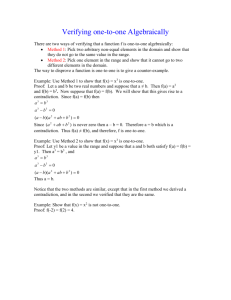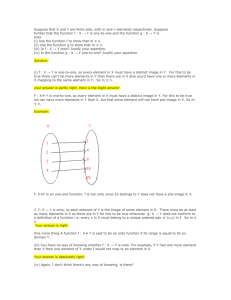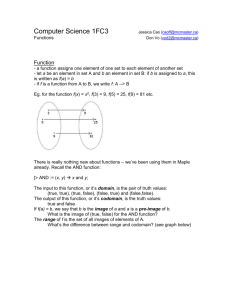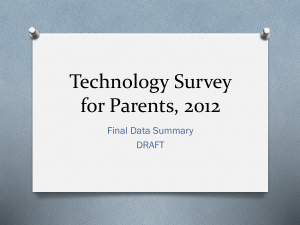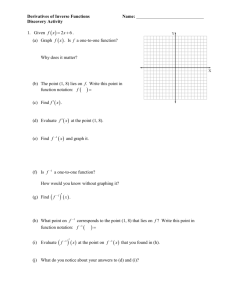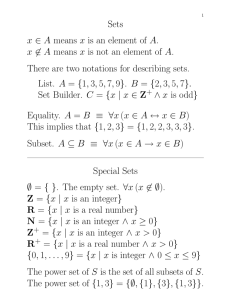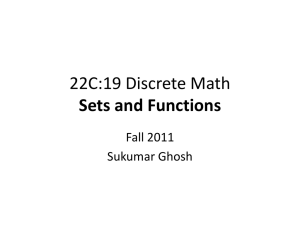Lecture 1
advertisement
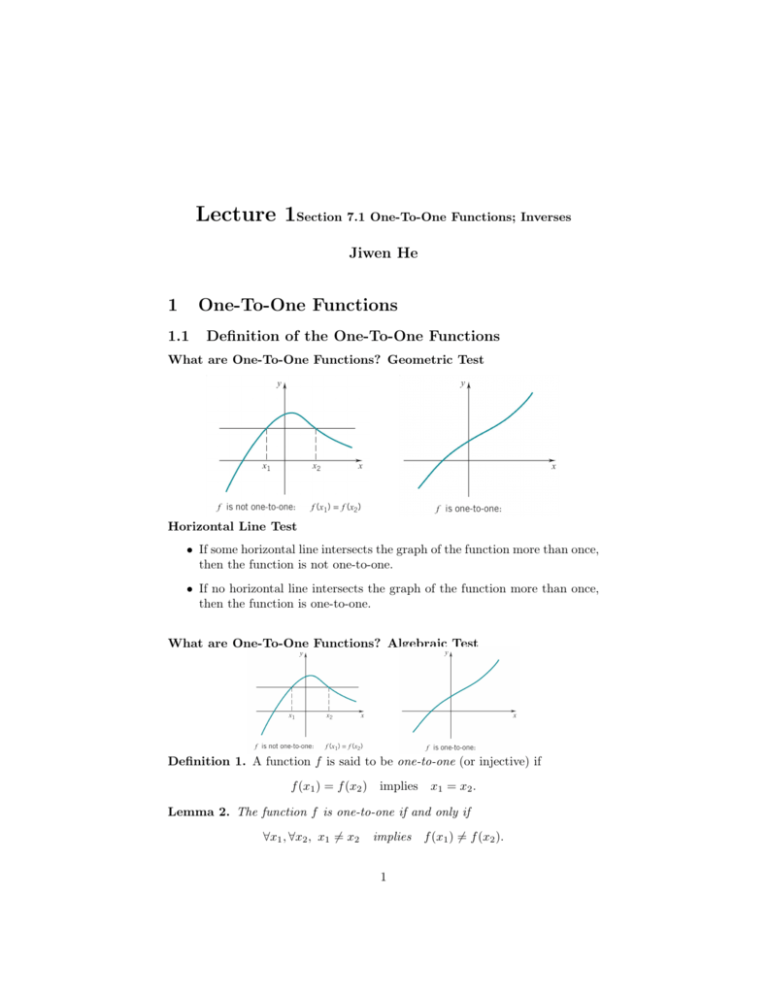
Lecture 1Section 7.1 One-To-One Functions; Inverses Jiwen He 1 One-To-One Functions 1.1 Definition of the One-To-One Functions What are One-To-One Functions? Geometric Test Horizontal Line Test • If some horizontal line intersects the graph of the function more than once, then the function is not one-to-one. • If no horizontal line intersects the graph of the function more than once, then the function is one-to-one. What are One-To-One Functions? Algebraic Test Definition 1. A function f is said to be one-to-one (or injective) if f (x1 ) = f (x2 ) implies x1 = x2 . Lemma 2. The function f is one-to-one if and only if ∀x1 , ∀x2 , x1 6= x2 implies 1 f (x1 ) 6= f (x2 ). Examples and Counter-Examples Examples 3. • f (x) = 3x − 5 is 1-to-1. • f (x) = x2 is not 1-to-1. • f (x) = x3 is 1-to-1. • f (x) = 1 x is 1-to-1. • f (x) = xn − x, n > 0, is not 1-to-1. Proof. • f (x1 ) = f (x2 ) ⇒ 3x1 − 5 = 3x2 − 5 general, f (x) = ax − b, a 6= 0, is 1-to-1. ⇒ x1 = x2 . In • f (1) = (1)2 = 1 = (−1)2 = f (−1). In general, f (x) = xn , n even, is not 1-to-1. • f (x1 ) = f (x2 ) odd, is 1-to-1. ⇒ x31 = x32 ⇒ x1 = x2 . In general, f (x) = xn , n • f (x1 ) = f (x2 ) odd, is 1-to-1. ⇒ 1 x1 ⇒ x1 = x2 . In general, f (x) = x−n , n = 1 x2 • f (0) = 0n − 0 = 0 = (1)n − 1 = f (1). In general, 1-to-1 of f and g does not always imply 1-to-1 of f + g. 1.2 Properties of One-To-One Functions Properties Properties If f and g are one-to-one, then f ◦ g is one-to-one. Proof. f ◦ g(x1 ) = f ◦ g(x2 ) g(x2 ) ⇒ x1 = x2 . ⇒ f (g(x1 )) = f (g(x2 )) ⇒ g(x1 ) = Examples 4. • f (x) = 3x3 − 5 is one-to-one, since f = g ◦ u where g(u) = 3u − 5 and u(x) = x3 are one-to-one. • f (x) = (3x − 5)3 is one-to-one, since f = g ◦ u where g(u) = u3 and u(x) = 3x − 5 are one-to-one. • f (x) = 3x31−5 is one-to-one, since f = g ◦ u where g(u) = 3x3 − 5 are one-to-one. 2 1 u and u(x) = 1.3 Increasing/Decreasing Functions and One-To-Oneness Increasing/Decreasing Functions and One-To-Oneness Definition 5. • A function f is (strictly) increasing if ∀x1 , ∀x2 , x1 < x2 implies f (x1 ) < f (x2 ). • A function f is (strictly) decreasing if ∀x1 , ∀x2 , x1 < x2 implies f (x1 ) > f (x2 ). Theorem 6. Functions that are increasing or decreasing are one-to-one. Proof. For x1 6= x2 , either x1 < x2 or x1 > x2 ans so, by monotonicity, either f (x1 ) < f (x2 ) or f (x1 ) > f (x2 ), thus f (x1 ) 6= f (x2 ). Sign of the Derivative Test for One-To-Oneness Theorem 7. • If f 0 (x) > 0 for all x, then f is increasing, thus one-to-one. • If f 0 (x) < 0 for all x, then f is decreasing, thus one-to-one. Examples 8. f 0 (x) = 3x2 + • f (x) = x3 + 21 x is one-to-one, since 2 2.1 Inverse Functions Definition of Inverse Functions What are Inverse Functions? 3 >0 f 0 (x) = −5x4 − 6x2 − 2 < 0 • f (x) = −x5 −2x3 −2x is one-to-one, since • f (x) = x−π+cos x is one-to-one, since and f 0 (x) = 0 only at x = 1 2 f 0 (x) = 1 − sin x ≥ 0 π 2 + 2kπ. for all x. for all x. Definition 9. Let f be a one-to-one function. The inverse of f , denoted by f −1 , is the unique function with domain equal to the range of f that satisfies f f −1 (x) = x for all x in the range of f . Warning DON’T Confuse f −1 with the reciprocal of f , that is, with 1/f . The “−1” in the notation for the inverse of f is not an exponent; f −1 (x) does not mean 1/f (x). Example 4 Example 10. • f (x) = x3 ⇒ f −1 (x) = x1/3 . 5 Proof. • By definition, f −1 satisfies the equation f f −1 (x) = x for all x. • Set y = f −1 (x) and solve f (y) = x for y: f (y) = x ⇒ y3 = x ⇒ y = x1/3 . • Substitute f −1 (x) back in for y, f −1 (x) = x1/3 . In general, f (x) = xn , n odd, ⇒ Example 6 f −1 (x) = x1/n . 7 Example 11. • f (x) = 3x − 5 ⇒ f −1 (x) = 13 x + 53 . Proof. • By definition, f −1 satisfies f f −1 (x) = x, ∀x. • Set y = f −1 (x) and solve f (y) = x for y: f (y) = x ⇒ 3y − 5 = x ⇒ y= 1 5 x+ . 3 3 • Substitute f −1 (x) back in for y, f −1 (x) = 1 5 x+ . 3 3 In general, f (x) = ax + b, a 6= 0, 2.2 ⇒ f −1 (x) = Properties of Inverse Functions Undone Properties f ◦ f −1 = IdR(f ) D(f −1 ) = R(f ) 8 b 1 x− . a a f −1 ◦ f = IdD(f ) R(f −1 ) = D(f ) Theorem 12. By definition, f −1 satisfies f f −1 (x) = x for all x in the range of f . It is also true that f −1 f (x) = x Proof. for all x in the domain of f . • ∀x ∈ D(f ), set y = f (x). Since y ∈ R(f ), f f −1 (y) = y ⇒ f f −1 (f (x)) = f (x). • f being one-to-one implies f −1 (f (x)) = x. Graphs of f and f −1 9 10 Graphs of f and f −1 The graph of f −1 is the graph of f reflected in the line y = x. Example 13. Given the graph of f , sketch the graph of f −1 . Solution First draw the line y = x. Then reflect the graph of f in that line. Corollary 14. f is continuous 2.3 ⇒ so is f −1 . Differentiability of Inverses Differentiability of Inverses Theorem 15. (f −1 )0 (y) = Proof. 1 , f 0 (x) f 0 (x) 6= 0, y = f (x). • ∀y ∈ D(f −1 ) = R(f ), ∃x ∈ D(f ) s.t. y = f (x). By definition, f −1 (f (x)) = x ⇒ d −1 f (f (x)) = (f −1 )0 (f (x))f 0 (x) = 1. dx 11 • If f 0 (x) 6= 0, then (f −1 )0 (f (x)) = 1 ⇒ f 0 (x) (f −1 )0 (y) = 1 f 0 (x) . Example Example 16. Let f (x) = x3 + 21 x. Calculate (f −1 )0 (9). Solution • Note that f 0 (x) = 3x2 + • Note that (f −1 )0 (y) = 1 2 > 0, thus f is one-to-one. 1 f 0 (x) , y = f (x). • To calculate (f −1 )0 (y) at y = 9, find a number x s.t. f (x) = 9: • Since f 0 (2) = 3(2)2 + 1 2 1 x3 + x = 9 2 ⇒ f (x) = 9 = 25 2 , ⇒ then (f −1 )0 (9) = x = 2. 1 f 0 (2) = 2 25 . Note that to calculate (f −1 )0 (y) at a specific y using (f −1 )0 (y) = 1 f 0 (x) , f 0 (x) 6= 0, y = f (x), we only need the value of x s.t. f (x) = y, not the inverse function f −1 , which may not be known explicitly. Daily Grades Daily Grades (c) 1 . x (c) 1 . x3 (b) x 2 , (c) 1 . x2 (b) 3, (c) 1 . 3 1. f (x) = x, f −1 (x) =? : (a) not exist, (b) x, 2. f (x) = x3 , f −1 (x) =? : (a) not exist, (b) x 3 , 3. f (x) = x2 , f −1 (x) =? : (a) not exist, 4. f (x) = 3x − 3, (f −1 )0 (1) =? : (a) not exist, Outline 12 1 1 Contents 1 One-To-One Functions 1.1 Definition . . . . . . . . . . . . . . . . . . . . . . . . . . . . . . . 1.2 Properties . . . . . . . . . . . . . . . . . . . . . . . . . . . . . . . 1.3 Monotonicity . . . . . . . . . . . . . . . . . . . . . . . . . . . . . 1 1 2 3 2 Inverses 2.1 Definition . . . . . . . . . . . . . . . . . . . . . . . . . . . . . . . 2.2 Properties . . . . . . . . . . . . . . . . . . . . . . . . . . . . . . . 2.3 Differentiability . . . . . . . . . . . . . . . . . . . . . . . . . . . . 3 3 8 11 13

